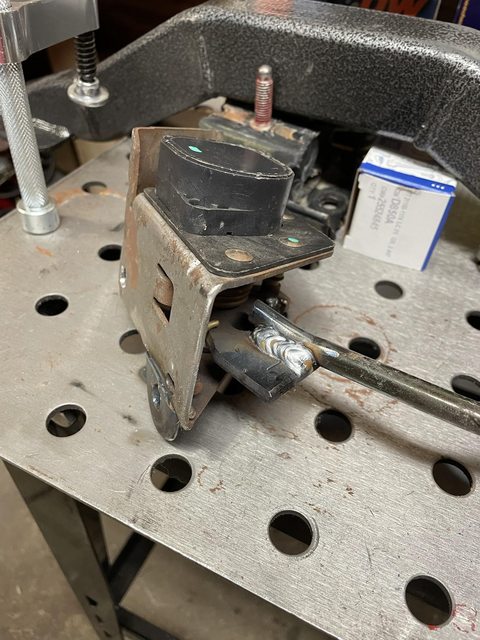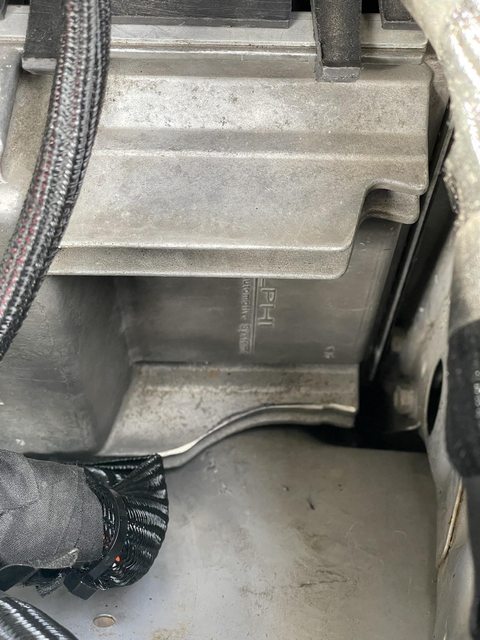Next you are going to want to take your new harness you bought (hopefully unloomed) and install it into the engine bay. This sounds like a pain, but you want to install it 100% onto the motor. Figure out all of your wire routing here. Plug in every single plug onto the motor.
Good place to start is figure out where the left bank and right bank wires are. Then figure out where you want your Injector wires to live. I found if you spin the injectors to face the rear of the vehicle, you can tuck the injector wires in pretty neatly, along with the coil wires. Plug in your TB and MAF on the passenger side, and your ect and alt on the other.
Once this is done you can find where the rest of the wiring will split off behind the intake near the firewall. you will have a ton of room back here, even if you spaced your motor as far back as it will go. This big area is a good place for the main junction of your harness to live, as half of your wiring will go down the bellhousing and towards the back.
Run each side of the harness down each side of the bellhousing for your trans wires, o2, etc on the driver side, and your starter wires, o2, crankshaft position sensor wire, starter solenoid, etc down the passenger side. These you obviously wont need to connect just yet. Once all of these wires are ran to where they need to be, you should have a fuse box just dangling around and your PCM/ECM connector just hanging out. This is now the part where you will find a place for these items to live.
You CAN depin the 30 or so wires from the PCM connector and run it through the firewall and run the computer inside the truck, most harnesses allow extra wiring to do so. This is also a giant pain so more power to you if you do this. You could just open up the hole in the firewall to be large enough to run the pcm connectors through it as well. All of these GM vehicles had the computers in the engine bay so they are safe under there. On the 60 theres a few spots right on the firewall near the back of the fenders on both the driver side and passenger side that is free real estate, as well as along the fenders or if you have ditched your wiper washer bottle, that bracket is pretty easy too.
If you are using a Gen3 motor you will also need to keep in mind you will need to mount the Tac module as well. With your harness mounted, you will see where you have wire length to mount your PCM/Tac Module/ and Fuse box. Mount the Tac module after the PCM as it connects to both the gas pedal and the PCM.
This is just what I did, there are surely other ideas out there but just kinda looking at it this is what I came up with. I didnt want to be able to see the big pcm so i tried my best to hide it. If you dont care you can make brackets or mount it elsewhere.
I used
NAL-15995679 from summit, which is a stock plastic PCM bracket. I Cut all of the tabs off of the end of it and found 2 existing holes on my firewall and drilled holes into the center of the bracket and counter sunk them and used countersunk allen bolts to mount it to the firewall. Then i trimmed one of the cooling fins to match the radius of the fender so i could shove it even further down into the bottom of the engine bay. Lastly I bent 2 brake lines to give me better access and mounted the PCM under and to the right of the Brake MC. I used the heat shield that is already there for my harness and ran it inside of it and into the back area of the motor behind the intake. You can also drill holes and use rivnuts to mount this if you want to mount it somewhere else. There are also a ton of other ECM/PCM brackets out there. Both aftermarket and factory from a variety of different vehicles. Find the one that you like the best and will allow you to mount. You want the PCM/ECM to be able to be removed in case you need to change wiring on the connector or if for some reason down the road the pcm needs to be replaced.
Doing it this way hides the PCM pretty well and gives me direct access to the hole that was once my Clutch master, which was used to run the cabin wires through. I still need to clean up the wires better, but this is how it sits now. I am thinking about making a cover plate to block off the entire corner so all of it is hidden.
Note* Mounting the PCM here gives you a lot of extra wire on the thick part of the harness that mounts to the pcm. Im too lazy to depin every wire so i just kind of twisted it and kept the slack. You can also see here that i used the old hood hinge bolts to mount my Tac module to the fender here and spaced it out slightly to allow the Gas strut from the hood to pass behind it. I really really dont like the look of all these wires in this corner. Thats a project for down the road.
Clearanced fin on PCM to allow deeper depth installation.
Bent Brake lines and running the harness behind the heat shield for protection. Be careful bending these lines, they are really long and if you break one youre going to have to replace the entire brake line. You can fit a brake line bender in there barely.
You can also see here that I replaced the bad toyota brake wiring connector with a Delphi GT150 connector. While you are in here, its a great time to replace your old dry rotten connectors with MUCH better delphi connectors. They are safer, and have locks on them, and are also more water and weather resistant. Do this on as many plugs as you can

Once you have the PCM mounted where you want it mounted, and make sure you can connect the connections to it, then mount your Tac module somewhere. Most of the kits give you a TON of room on these wires so youll want to use the delphi terminals and your open barrel crump to cut these wires, crimp new ends to them and shorten them once you have the positioning of the tac module good.
Lastly youll mount your fuse box. I didnt want to see this thing either but still needed access to it, so i mounted it low on the fender under my air compressor. You really can mount this anywhere you have the wire length to mount it. Just make sure its not too hidden that you cant access the fuses or get a multimeter onto it. For this just drill holes and put some rivnuts into the sheet metal
This is a part of the swap where you can get creative. Theres no one set way to do it. you can tuck and hide wires, position things so its not in direct eyesight etc. Theres a million ways to mount this stuff. Check out shops and other swaps to see what you like and dont like. Or just wing it like i did. Theres really no wrong way to do it.
Once you have everything mounted where it needs to go, here is where you will take your harness and group stuff together. Use a combination of painters tape and colored zipties to connect wire runs that are travelling to the same area so you can bundle them together, then mark where they split off. This way you can buy less loom and it will look better. Instead of a ton of loomed wires youll have fewer thick ones with smaller branches. For example, you can lump the TB wire and the MAF wire together all the way until they split near the TB, then after that they will get their own loom. You will be looming this on the floor or whatever and not in the truck, so at this point you are trying to get as much info as you can.
Next youll want to mark the wires that are near heat. O2s, starter wires, etc. Anything coming REMOTELY close to your exhaust on either side of the transmission. You are doing this because youll want to buy some insultherm high temp loom for these sections. You can do your entire harness in this stuff but its pretty expensive and its not split so youll have to depin every plug to feed the wires through it. I only did the wires that come close into contact with heat.
Lastly, youll want to start marking wires that are too long on your harness. You want to shorten the wire runs so theres a little bit of slack, but too much slack and wire laying down for no reason looks junky. The reason you 100% connected your harness to where you want it to live is to get the exact lengths of every wire run after you have done your fancy wire routing to hide wires and what not. 90% of the time you are going to be shortening wires, but depending on your routing you might need to lengthen one. Mark all of this stuff now so you can remember to do it on the floor when you are looming it up. You will be using your open barrel crimp tool for this and your delphi GT150 terminal ends. If you want to shortcut it i guess you could cut the wires and then splice the already crimped ends to the shorter wire but with how cheap the delphi terminals are, just do it right and youll never have to touch it again.
When shortening the runs, take a ton of pictures so you remember what color wire goes where in the plug. This will help you a ton.
After all of this is done, you can remove the entire harness from the vehicle and lay it out on your floor. You should have all of your bundled shared runs next to each other and paired off together. Here you will start measuring for what type of loom you are going to need, if your harness didnt come with loom. You will need different sizes so just measure the thickness of the shared runs, and then where they split off for the lengths. After you have your total lengths of loom, add 5 feet to each size just in case for mistakes. Also remember to measure for your Insultherm high temp loom here as well on the pieces you marked that were exposed to heat.
In this photo you can see the grouped wire runs together, the big split on the lower end from the large bundle to the smalller runs on the bottom is the back of the engine by the firewall.
Figure out what type of loom you want to buy for the normal pieces, Split woven loom is pretty cheap, you can get it on summit, or amazon or whatever. Its all the same stuff. This stuff is mostly for abrasion resistance and doesnt have a super high heat tolerance so getting expensive loom for your entire harness is a waste. You can just order it off amazon or ebay and be all good for a quarter of the price of the name brand stuff.
For the high temp stuff, youll want name brand loom like insultherm, fire wrap, or volcano. You can order this stuff by the foot online if you look for it. I got a few samples and the insultherm looked the best. It works kind of like a Chinese finger trap, you push it together and its bigger, pull it apart and its smaller in diameter. Measure your wires accordingly.
When you get the loom, youll want to remove the zip ties from your harness that are holding it together and replace with loom, your own zip ties, and Tessa high temp tape as you go. Dont remove all the zipties at once, this will help it stay organized. You can use the tessa tape on the ends and on the unions of wires to seal the loom better and cover the ends. When you are running junctions in the loom always be sure to overlap your loom by a few inches for the best protection then run the tape over the junction. If you just butt them up together it will slide apart or youll have some exposed wires depending on how you twist it.
Also when you are cutting the split woven loom use very sharp scissors, then hit them with a lighter quickly on the ends to melt the frays. If you hold the lighter there too long it will fray even more. Youll get the hang of it really quickly.
Also, pretty important, do one of these at a time, and when you loom the wires, re tape your wire labels that came on the harness very securely, some of these wires will be pushed through the firewall and if you lose a label it will add time to figure out what is what.
Here is my loom partially loomed up and taped. This was still waiting on the Insultherm and to shorten the super long Tac module wires to the left.
Once the harness is completely loomed, you are ready to install it back into the engine bay for the final time. After doing all of this you can see why you want to get an unloomed harness. It is more work, but you are able to tailor your harness to your engine bay much better than if you had bought a preloomed harness and just threw it in.

www.speedwaymotors.com

















































